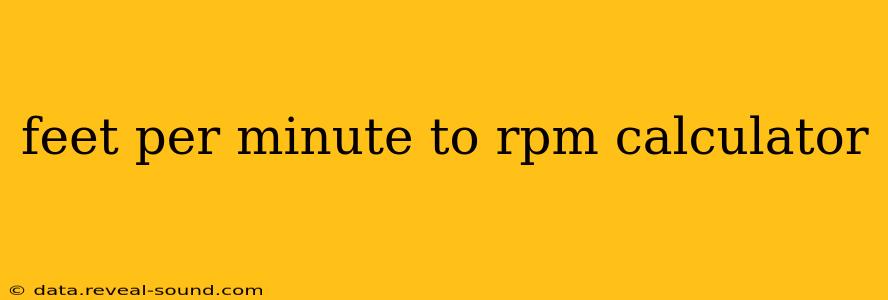Converting feet per minute (FPM) to revolutions per minute (RPM) is a common calculation in various fields, from machining and manufacturing to robotics and engineering. Understanding this conversion is crucial for ensuring machinery operates at the correct speed and for accurate process control. This guide will walk you through the process, explain the underlying principles, and answer frequently asked questions.
Understanding the Conversion: FPM to RPM
The core principle behind converting FPM to RPM lies in understanding the circumference of the rotating object. The circumference represents the distance covered in one revolution. To convert FPM to RPM, we need to know the diameter or radius of the rotating object.
The Formula:
RPM = (FPM * 12) / (π * Diameter)
Where:
- FPM is the speed in feet per minute.
- 12 is the conversion factor from feet to inches (since the diameter is usually measured in inches).
- π (pi) is approximately 3.14159.
- Diameter is the diameter of the rotating object in inches.
How to Use the Formula: A Step-by-Step Example
Let's say a conveyor belt is moving at 100 feet per minute (FPM), and the diameter of the drive pulley is 6 inches. To calculate the RPM of the pulley:
- Plug the values into the formula: RPM = (100 FPM * 12) / (π * 6 inches)
- Calculate: RPM = 1200 / (3.14159 * 6) ≈ 63.66 RPM
Therefore, the drive pulley is rotating at approximately 63.66 RPM.
What if I know the radius instead of the diameter?
The formula can be easily adapted if you know the radius (half the diameter) instead:
RPM = (FPM * 12) / (2 * π * Radius)
How does this conversion apply to different applications?
This conversion is vital in various applications:
- Machining: Calculating the spindle speed for optimal cutting performance.
- Conveyor systems: Determining the speed of rollers and drive pulleys.
- Robotics: Controlling the rotational speed of robotic arms and motors.
- Pumping systems: Calculating the RPM of pump shafts based on fluid flow rates.
- Gear ratios: Calculating the output RPM of a gear system given the input speed in FPM.
What are some common mistakes to avoid when converting FPM to RPM?
- Using inconsistent units: Ensure all measurements are in the same unit system (e.g., feet and inches or meters and centimeters). Mixing units will lead to incorrect results.
- Forgetting the conversion factor: Remember to multiply the FPM by 12 to convert feet to inches before applying the formula.
- Using the wrong formula: If you know the radius, make sure to use the adapted formula.
Are there any online calculators available to simplify this conversion?
Yes, several online calculators are available that can perform this conversion automatically. Simply search for "FPM to RPM calculator" on your preferred search engine. These calculators often provide a user-friendly interface and can save you time and effort.
What other factors might influence RPM calculations?
The accuracy of your RPM calculation depends on precise measurements of the FPM and the diameter (or radius) of the rotating object. Slippage in belts or gears can also introduce error.
Can I convert RPM to FPM?
Yes, the formula can easily be rearranged to convert RPM to FPM:
FPM = (RPM * π * Diameter) / 12
This comprehensive guide provides a clear understanding of converting feet per minute to revolutions per minute. By accurately applying these formulas and avoiding common mistakes, you can ensure precise calculations in various applications requiring this essential conversion.
